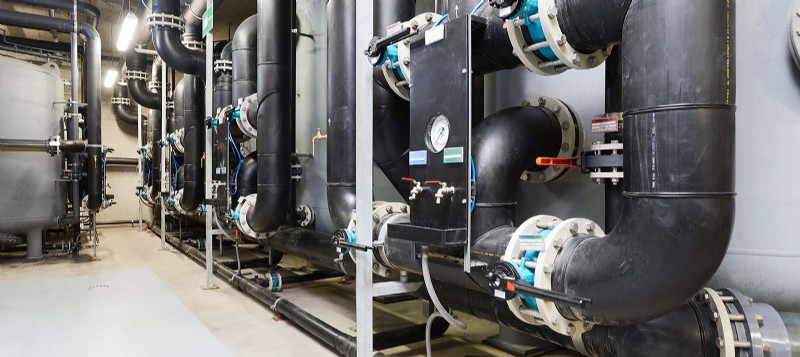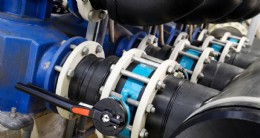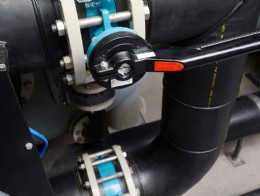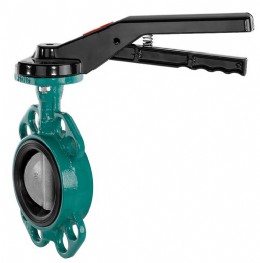GEMÜ butterfly valves in swimming pool systems
Application in the water treatment plant of an outdoor swimming pool




GEMÜ D487 Victoria Butterfly Valve
There are two key steps here, the first step is preparing the raw water for use in the swimming pool. The second step is continuously pumping the water in the swimming pool through a circuit and thereby cleaning it to maintain its quality and keep it free of contaminants or germs that could potentially cause illnesses. Any water that has been lost, for example due to evaporation in open air pools, is also replaced during this process.
The water in the swimming pool must comply with a wide range of quality criteria. Alongside microbiological requirements (limit values to be met, e.g. for bacterial cultures such as E. coli or Legionella pneumophila), these also include chemical and physical requirements (e.g. pH value, nitrate concentration and concentration of free and bound chlorine). DIN 19643, known as the “swimming pool standard,” provides orientation with regard to the guideline values to be met and documentation of the prevalent water quality. Among other things, it includes standards pertaining to the pH value, which must be between 6.5 and 7.2, as well as the concentration of free and combined chlorine.
Water treatment
But what exactly happens when the water leaves the swimming pool via the overflow channel and what processes are required to prepare the water for re-use?
First of all, the raw water flows into a raw water reservoir. From here, it is pumped back out again using a circulating pump. At the same time, a flocculant containing specific aluminium salts is added. This causes the dirt particles in the water to clump together, which has a positive impact on sedimentation and filtration. This flocculation also helps control phosphate-based components that would otherwise promote excessive growth of algae.
Once the raw water is treated in this way it is then filtered. The filter removes a wide range of suspended matter (solids and minute organisms) from the water. Alongside the hair, saliva and skin of those using the pool, these contaminants also include leaves, blades of grass, soil, insects or similar, especially in outdoor pools.
Filtration with a multi-layered system is a standard procedure used for this, whereby gravel or sand are typically used as the filter material. To ensure optimum cleaning of the water flowing through the filter, as well as to prevent any contamination, these multi-layer filters are cleaned regularly. This is the only way to prevent bacteria from settling on the surface of the filter material that could then re-contaminate the water that has already been pre-purified. Besides the multi-layer filters, ultra-filtration is another option that is occasionally encountered at swimming facilities.
The water pre-purified in this way is classed as filtrate and disinfected in the subsequent process step. This is performed through chlorination, e.g. using chlorine gas. Clean and reliable results can only be achieved through a combination of physical methods (e.g. filters) and chemical methods (e.g. chlorination) for cleaning and preparing the water for use in the swimming pool.
The water quality in a swimming pool must be permanently monitored. This typically involves an automated process for taking samples of pool water at regular intervals, so that the water quality can then be adjusted as necessary following analysis. This can include increasing or reducing the chlorine content of the water. If an excessively high concentration of combined chlorine is detected, the water is then passed through an activated carbon filter, for example. This additional process step allows combined chlorine to be removed.
Once the raw water has been completely cleaned and treated, it is referred to as pure water, which can then be fed back promptly into the swimming pool.
GEMÜ products
The GEMÜ D487 Victoria soft seated manually operated butterfly valves available in nominal sizes DN 25 – 1600, perform various shut-off functions in the supply and discharge lines of the water treatment plant.
Key Features
• Advanced seal design - even for larger diameters
• Modular construction • Extensive applications using a variety of materials
• Simple installation
• Drinking water approval DVGW
Tel: 01925 824 044
Email: enquiries@gemu.co.uk
Web: www.gemu.co.uk
Published: 29th April 2019
Valveuser Magazine Issue 91 is the first of our Special Print Editions for ...
BVAA’s Director Rob Bartlett comments, “In 2024, the BVAA will be ...
Spring Conference & Golf Day, 22-23 May 2024 at Mottram Hall, ...
As 2024 is BVAA’s 85th Anniversary year, I recently had the perfect ...
The international event of reference for industrial valves and flow control ...
As long-term readers of Valveuser will know; Heap & Partners Ltd was ...
WIRRAL manufacturer Heap & Partners has recently celebrated one hundred ...
IMI has announced a record year for orders throughout the hydrogen value chain ...










